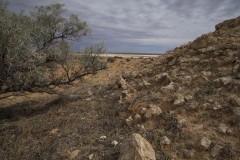Back on the famous French Line, our morning progress slowed considerably. Not hard at all, but second gear was the order of the day as the dunes became steeper with switchbacks on the crests thrown in to keep us awake. Camel poo prevailed, but still no camels. We did consider whether our poo identification prowess was lacking and that maybe it was the creation of a dingo. Deciding that it would have to be one hell big of a dingo to leave deposits of such magnitude, we elected to go with our first view and continued the lookout for camels.
A couple of hours passed before we ventured upon the left turn to the Approdinna Attora Knolls, but a few short kilometres away. The ground hardened appreciably, white rocks strutted out of the surface and the world was a different place to half an hour earlier.
The knolls are, well let’s face it, a pretty sad excuse for a broken-down hill of no magnificence. There is a couple of them so they don’t get lonely so far from civilisation, but wasting ink to mark off the bucket list is not advised. Still, a walk up revealed a good look at a nearby salt pan and let us see the build-up in the skies of what was to come. Before departing we read about how the rain ancestor hung out around these parts. Not out of bed today, we had no idea yet what a grudge this bloke could hold.
Heading south, we lunched at a wide part of the track, fixed a wiring connection on the Toyota and plodded ever so relentlessly to meet the Rig Road, before heading west again.
An hour or so more, but who’s counting in the desert, we came upon the Lone Gum. Not only does this single tree offer evidence of the ability of plants to survive where they shouldn’t, it marked the turn left to head south once again keeping true to the Rig Road. We noticed that the lovely purple flowers were no longer, clearly not liking this part of the desert. The white ones prevailed. A few yellow popped their heads up for effect.
Driving between the dunes, the going should have been easier. Who would have thought that corrugations would prevail to such an extent in a world full of soft sand? The dunes here were lower, with the track occasionally popping over one or two just for fun and often traversing the top of a dune for a kilometre or two.
As we once again turned west, we knew this day was going to be one to remember. The sky now was black. It came in dark black, dark blackish grey and jet black. There was no blue. The sun was yesterday’s news. We all knew that making a mile was priority one at this stage.
Initially our goal became traversing the long Rig Road, 48 kilometre straight, directly into steeper sand dunes to make it just on dark to the point where road again turns northish. With concerted effort we made it to that point, found a possible camp spot then realised that the lovely area protected from wind was a small clay pan. With rain a certainty and heavy rain a likelihood, playing in clay was about as uncool as we could get.
The environment, our safety and the warmth of our respective cars dictated we continued on to the supposed relative safety of Lynnie Junction where the Rig Road meets the WAA line. Every trip has at least one epic driving sequence. This was one. With spotlights turning night into day, we punched north with the wind howling and the rain ever more threatening. The night had an eerie feel. We individually and collectively felt just a little bit vulnerable as the endless corrugations shook any decency out of us.
Finally, the junction came. We grabbed a camp spot. Threw our tents up and cooked a dinner in quick time. Our tents had been set up to combat the south-westerly wind. Sometime around, I’m almost asleep but not quite’, it changed entirely and smashed us all night from the north east, in what was a night of wondering if we would do a Harry Potter and fly across the landscape ending up in Western Australia.

